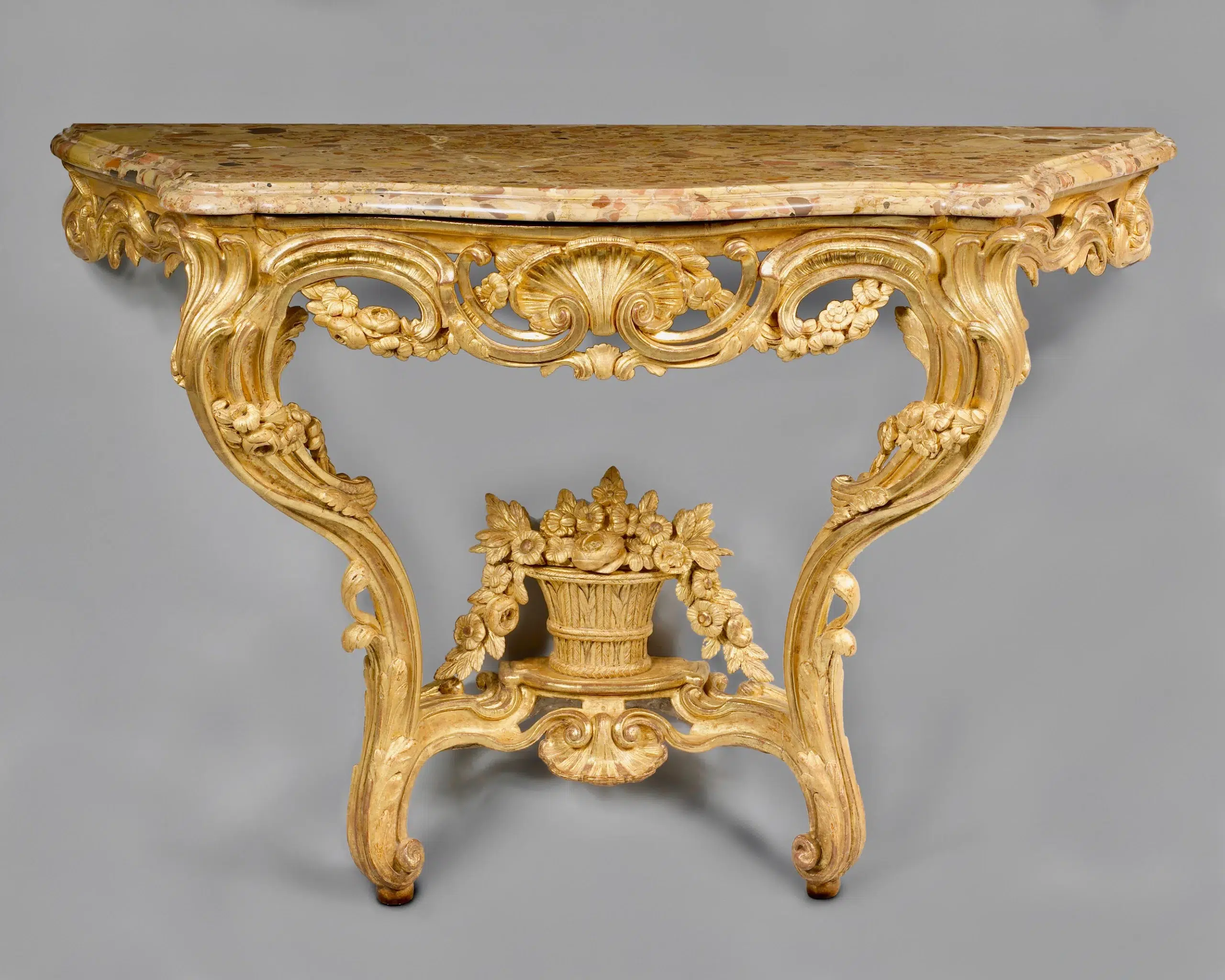France, Louis XV period, circa 1750
Attributed to Nicolas Heurtaut (1720−1771) or Nicolas-Quinibert Foliot (1706−1776)
Carved and gilt wood
Breach of Aleppo marble top
Close example:
- Pierre Contant d’Ivry, Drawing realized for the game room of the Palais Royal, at the request of the Duke of Orléans, 1753–1754
Of gilt wood, this fine console is richly carved and adorned of flowers, garlands of leaves, with, a shell on the center. It is based on two curved legs decorated with acanthus leaves, connected by a spacer, surmounted by a reverse shell, topped with a large basket of flowers.
Marble top breach of Aleppo.
The “classicizing symmetrical rocaille” style
This console is part of a style described as “symmetrical classicist rocaille”, which was born around 1753 and which consists of a balance between rocaille and antique classicism. Indeed, its rocaille form is tempered by a strict symmetry and the basket full of roses, placed on the brace, as well as the “roller” feet, are elements marking a return to a classical repertoire.
The main representative of this style was the architect Pierre Contant d’Ivry (1698−1777), who was designing the Royal Palace at the time. The shapes of this console present elements very close to those appearing on a drawing of Pierre Contant d’Ivry realized for the game room of the Palais Royal at the request of the Duke of Orleans in 1753–1754.
Only two master carpenters seemed to have worked according to the principles of the “symmetrical classicist rocaille” and can therefore be the authors of this console: Nicolas Heurtaut and Nicolas-Quinibert Foliot.
Nicolas Heurtaut (1720−1771)
Son of Claude Heurtaut, seat maker, he married the daughter of a carpenter Guillaume Antoine Destrumel. He became a master sculptor at the Académie de Saint Luc in 1742. From 1742 to 1753, he should exercise as a sculptor of seats, rue de Clery, for Tilliard, Senna and probably Avisse and Saint-Georges. In 1753 he was received a master carpenter. He settled down Bourbon Street and served as master sculptor and master carpenter from 1753 to 1771.
Nicolas Quinibert Foliot (1706 – 1776)
Son of Nicolas Foliot, seat maker, he was received master carpenter in 1729 and settled rue de Clery. After the death of his father (1740) he began to deliver to the Garde Meuble Royal until 1775. He was the representative of a large dynasty of seat makers especially with his three brothers, Gabriel and François Toussaint (seats sculptor), his son and his nephew Louis Quinibert François Toussaint.
Nicolas-Quinibert regularly delivered to the Crown as menuisier du Garde-Meuble du Roi. Among the few specific customers, we see the Marshal d’Estrées, the baron Bernstoff under the direction of Contant d’Ivry or Louise Elisabeth, daughter of Louis XV and Duchess of Parma.
Bibliography
- Bill G.B. Pallot, L’art du siège au xviiie siècle en France, Paris, 1987
- Bill G.B. Pallot, Le mobilier du Musée du Louvre, tome II Siège et consoles (menuiserie) xviie et xviiie siècles. Paris 1993
- Collective catalog, 18e aux sources du design, chefs‑d’œuvre du mobilier 1650–1790, Versailles, 2014
Measurements:
- Height: 33 ½ inches – 85 cm
- Width: 49 ¼ inches – 125 cm
- Depth: 20 ½ inches – 52 cm
